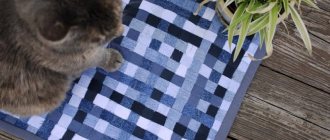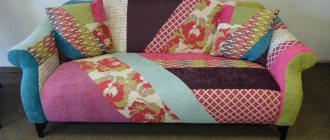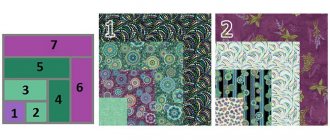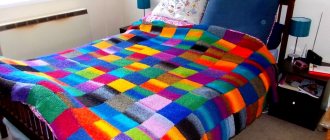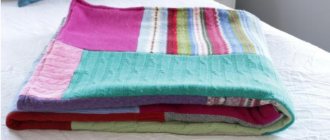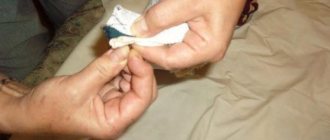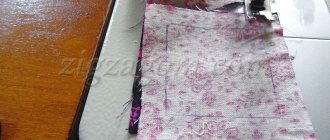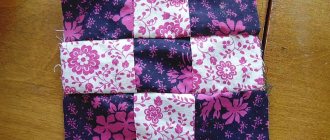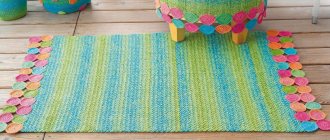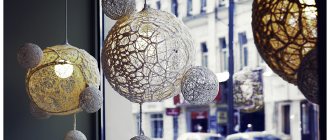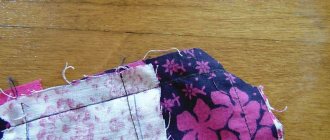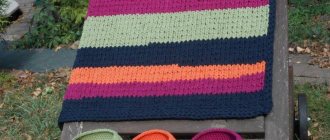Craftsmen have always used a wide variety of items for home crafts. You can make a lot of things with your own hands from a piece of already unnecessary fabric - these are beautiful curtains, bedspreads for armchairs, bright and cheerful rugs for the nursery and corridor, and even covers for flower pots. But the most popular are scraps of fabric obtained from old jeans. It is a dense and attractive fabric that can be used for a variety of purposes. For example, you can quickly and easily make a beautiful patchwork blanket from old jeans.
Pattern of bedspreads with dimensions from old jeans.
This blanket can be used for different purposes. It is perfect for a nursery if you use bright scraps of fabric for decoration. Such a blanket will be suitable for going on a picnic; it can be used as a comfortable and very warm bedding. For the job, all you need is a pair of old denim trousers, preferably in different colors, and the ability to work with a sewing machine . With a little imagination, you can transform the interior with your own hands, creating unusually attractive new things from old ones.
Patchwork styles and patterns when making bedspreads from old material
For any of the craftsmen - from beginners to professionals - they have come up with their own styles of stitching pieces into a canvas. Each type has its own characteristics and speed of production of the final product. The following popular patchwork styles are distinguished:
- Traditional style. Ideal for beginners who are just trying their hand at it. The style consists of gradually sewing together pieces of denim using a simple machine stitch. The result may be geometric shapes and ornaments that were previously conceived;
Quick square technique
- Quick square. It is also easy to perform and does not require any extra skills. For this, rectangles are taken from several fabrics and sewn along the long side, and the rest is hemmed to the resulting length.
- Watercolor style. A more complex and time-consuming option: the pieces are connected in a certain sequence of colors to get a picture or pattern. It is important to achieve a gradual change in shades of one or more colors.
- Stitching in stripes. The finished fabric will consist of strips of old jeans, sewn in a certain sequence. It can be a herringbone, zigzag or diamond pattern.
Triangle style
- Triangular style. Isosceles triangles are cut out of old material, merging along the short sides and forming motley stripes.
- Linking fragments. It does not mean stitching, but rather tying together pieces of jeans. Most often, threads made of natural and acrylic materials are used for this.
patchwork patchwork
Schemes for making a bedspread
The most beautiful products are obtained when needlewomen work using the same technique. There are different options for patterns: some people prefer to use large pieces of fabric, while others prefer small ones.
So, you can create all kinds of patterns. Some professional craftswomen prefer the technique of creating patchwork quilts from pieces of fabric of different lengths and widths. We will look at the most well-known techniques that have been successfully used for many years.
Blankets in various techniques
Table No. 1. Common techniques for making patchwork quilts.
| Option | Description of work |
| Quick square | This is the most primitive technique for making a product, which is best suited for novice craftsmen, thanks to which even creating a massive blanket will only take a few hours. Making a quick square is not at all difficult. You need to take denim (jean fabric) of two different shades, then cut out two identical rectangles and sew them together. Then you need to go over the seam with an iron. Then you can cut the same rectangle from a material of a different shade (its length should correspond to the length of the previous workpiece). Next, all these fragments are stitched together. These squares can be used to create any size blanket. |
| Watercolor | In this case, the color of the material is of great importance. After all, fabric fragments are connected to each other in a certain color sequence. By working with this technique, you can even create a color transition (ombre effect). In this case, first only the dark flaps are sewn together, gradually adding lighter ones. Keep in mind that not every beginner can cope with this process, because you have to spend a lot of time just choosing a shade for the transition. |
| Stripes | Another easy technique is to create a blanket from stripes. They can be completely different sizes. First, you will have to cut the denim fabric according to the parameters - it is from these strips that it is easiest to create your own, unique pattern. You can attach them to each other in any order, the main thing is that the product has an aesthetic appearance, so it is better to display the diagram of your actions on a sheet of paper in advance. |
| This is the name for a professional technique for creating a patchwork quilt, which beginners cannot always handle. Here you can already use any shades of material and shapes of patches. So, the craftswoman will have to sew all sides of such parts. It is worth noting that this method is more suitable for those who have only small pieces of jeans and do not have a whole product. It will not be possible to make figures of the same shape from the pieces, and in order not to throw away these fragments, the best solution would be to create a product in this unusual style. |
Making a denim blanket from pieces of fabric is not at all difficult
Patchwork denim blanket
Where should newbie quilters start? The simplest product that can be sewn using the patchwork technique is a bedspread, rug or pillow. It does not require special skill or long experience, but a beginner will immediately see the results of his work and receive a finished product.
Before sewing, you need to determine the size of the bedspread in order to calculate the size of the flaps. It is most convenient to work with pieces of 12 by 12 cm. For a standard bedspread for one person, you will need 352 squares of this size.
Before cutting the material, it needs to be prepared. Trousers or other items are ripped out, washed, ironed and steamed. Do not use too high temperatures so as not to deform the fabric. After the old trousers or shirt are ripped open, square blanks are cut out of them using a pattern.
Master class on making bedspreads with your own hands for beginners:
- The denim flap is applied with the wrong side to the wrong side of the lining and folded so that the denim is on top. Then two pieces of fabric are stitched together.
- The resulting blocks are connected to each other in series, with the wrong side facing each other. This produces long strips of fabric.
- After several such strips have been formed, they are combined into a single piece and sewn together with a seam on the front side.
The second technique is called crazy. For a crazy bedspread, it doesn’t matter what size and shape the pieces of jeans are; even the smallest scraps can be used. Sewing begins from the main, central section. The basis is a polygonal flap with at least 5 corners, preferably 6–8-angled. Counterclockwise, other pieces are attached to the sides of the polygon. It is important to sew the flap to the base with the smaller side so that the cover turns out even. Blankets made from jeans patches go well with pillows made using the same technique.
Techniques for stitching flaps
It is recommended to make a blanket from denim scraps yourself only after training on light types of fabrics.
To do this, you will need to sew a blanket from square-shaped scraps of different shades, connecting them together with a machine stitch. The front part is made of shreds, and the back part consists of a lining of one large piece of fabric.
You can use unnecessary curtains, tablecloth or bed linen. Despite the wide variety, the most popular stitching methods can be identified: squares, watercolors, stripes or patchwork.
Stripes
Sewing with stripes is the simplest and allows you to quickly make a bedspread with an ornament or pattern.
It is possible to sew the fabric, forming it from scraps, according to the following instructions:
- Sew the flaps back to each other in stripes. Leave the remaining seam up to 1.5 cm wide on the front area.
- Form strips - 10, 15, 20 pcs. by parameters.
- Sew the strips together and stitch the lining at the bottom.
- On the front area at the seams, make a fringe using scissors.
To make a seam with fringe, the fabric will need to be cut along its length, moving 5 mm away from the seam. Pull out the transverse threads with a brush or your hands, and then fluff the edges of the fringe. In the case of making fabric without fringe, the blanks are sewn in strips so that the seams are hidden from the inside.
There is an additional method for stitching with stripes, which involves making a pattern. Strips of material look unusual in the form of logs, zigzags, diamonds, and fir trees. To begin with, prepare a sketch, according to which the stripes are created, and a blanket is made from them according to the intended pattern.
Patchwork
Very often, when interacting with textile materials, handmade craftsmen turn to the patchwork technique, since old jeans can be used to make a blanket based on rounded parts. This may require up to 5 pairs of trousers, a CD and a set of sewing tools.
A master class on making canvas using the patchwork technique is described below:
- When the material is prepared, apply circles to the surface of the material on the underside using a CD and a pencil.
- Draw an odd number of fragments along the contours and display a geometric figure in each.
- Along the folds, sew all the flaps together so that the stitching is even.
- Sew all marked seams, steam the circle allowances or smooth them with an iron.
- Sew the allowances with a zigzag into the inside of the rounded flaps, stitch the fabric, edge it or sew on the lining.
To create a bright product, multi-colored square-shaped scraps of any fabric or insulating material can be placed in the circles before zigzag stitching. The design is based on the accumulation of a large number of denim details, the edges of which are stitched and then decorated.
If you don’t have a lot of jeans, you can use any denim items or alternately use scraps with inserts and other material. The thinner the material, the easier it is to process and create stitches.
Watercolor
The originality of this technique is based on the fact that the fusion of denim bases is based on their combination in a set sequence, taking into account the color scheme of the material.
Initially, the plaid is created from light-colored material, placing them in the central part, and squares of dark shades are added closer to the ends. You can also do the opposite - dark middle, light ends.
The features of sewing a blanket are described in the following steps:
- Select the fragments of the flaps so that their colors smoothly intersect with each other.
- Alternating from light to dark and vice versa can be done to the center or in a spiral.
- The most important task is to create a visual effect when applying a color palette.
This work requires a lot of time and patience, since the technique is complex in selecting a color shade from a certain number of rags. The result will be a blanket that looks original with furniture upholstery, and will also improve your watercolor stitching skills.
Quick squares
The square stitching method is suitable for less experienced craftsmen. It is necessary to master the design of three-color squares from several pairs of trousers of different shades.
Also cut out 2 rectangular flaps from 2 different materials and stitch them along their entire length. The resulting seams on the wrong side are smoothed out and steamed. The third blank is made from fabric of another color range in the form of a rectangle identical to the width of the strip of 1 and 2 geometric shapes.
All prepared materials are sewn on the outer areas so that the sleeve comes out. You can cut out three-color squares from the resulting product, and also use blocks to sew the bedspread together.
Products made from scraps have always been in great demand, especially today at the peak of the popularity of handmade things. This textile will help decorate absolutely any room. Despite all the difficulties of tailoring, the finished product will turn out to be very unusual and exclusive.
What do novice needlewomen need to know?
Making a blanket from old jeans with your own hands is quite simple, because the way of joining fabric fragments is reminiscent of a regular mosaic. In order to obtain such a product, it is important to maintain consistency during work.
First you need to select materials and prepare all the necessary equipment. This must be done so that everything is at hand during the work process. Next, you have to choose the most suitable scheme - here it is important to take into account your personal preferences and the characteristics of the material.
Approximate scheme for making a blanket
Craftsmen use a variety of patterns to create quilts, and you can choose one of them or design your own. Beginners are recommended to choose the most primitive and fastest option. At the same time, the finished blanket will look no worse than more complex products. So, you can gain experience, after which any scheme will not seem too difficult.
Homemade patchwork quilt
It is important to remember that any old product from which you plan to make a blanket should be brought into a neat appearance (washed and ironed). In this case, washing should be as gentle as possible at low temperatures so as not to damage the structure of the material. For extra softness, you can dip your jeans in rinse aid.
Rules for caring for denim
Round patchwork technique
In the process of work, it is not necessary to use only squares or rectangles - some craftsmen prefer to make blankets from round pieces of fabric.
In this case, you will need to prepare the following:
- disk;
- a simple pencil;
- scissors;
- old jeans;
- sewing supplies.
Step-by-step instruction
Step 1. You need to carefully iron the old jeans, then draw circles on them on the back side, using a disk (stencil) for this. After which they should be cut out.
Round blanks
Step 2. From the wrong side of our parts we draw an even square.
Draw a square on the other side
Step 3. Next you will need to fold the fragments together with the front sides facing inward. In this position, the parts should be basted. At the same time, some craftswomen prefer to exclude this step, but beginners are advised to make an outline. Then you can sew the details.
Making a stitch using a sewing machine
Step 4. Next, you need to lay out the parts and straighten the allowances.
Straightening the allowances
Step 5. Next, you should make a zigzag seam on the bend (you need to set certain settings on the sewing machine).
Making a zigzag seam
Step 6. Next you need to make a hem and sew such parts together.
Sew the parts together
Step 7. Based on this model, you can make a blanket - to do this, you need to put a piece of another material inside.
Take pieces of another material Place the scraps inside Sew the parts together
Video - Method of making a blanket from jeans
Which jeans are best to use?
Even though blankets are made from old jeans, they should only be made from durable fabric. Therefore, you should choose them taking into account the following nuances:
- It is better not to use any worn fragments of jeans for work. If they are present, it is better to carefully cut them out with scissors. Any parts with holes are also not suitable for making a blanket; it is better to get rid of them immediately.
- The material should be of a single color, in which case the product will turn out to be especially attractive and even strangers will not suspect that it is made from scraps. You can combine denim material of different colors in one product, but it must have the same structure.
Old jeans should look neat
In some cases, craftswomen skillfully combine fabrics of different textures in one product. So, during the sewing process they add fragments of burlap, velvet and other materials.
Blue wedding dress - photo of a dress in original colors and shades
Before you start:
- Wash denim pants or other denim items and dry them.
- There is absolutely no need to rip out every seam on the product; it will take too much time and effort. Arm yourself with scissors and cut the garment around the perimeter near the seams, leaving only the usable portion of the material. Throw away whatever is left over, or save it to create jewelry.
- Carefully inspect the material for stretch marks and damage. Pay special attention to the areas of the knees and hips, they are most susceptible to stretching.
- Cut off the back pockets and leave them for decoration.
- Gather all the resulting fabric together, and now you are ready to cut out the parts for your future bedspread.
Universal Soldier
If the wardrobe is imagined as an army headquarters in the service of a beautiful lady, then jeans will play the role of a faithful squire, who is with his general both at feast and at peace. And if we return to reality, the fabric from which comfortable and beautiful trousers are made is so practical that, even if slightly frayed, it does not lose its strength and attractiveness. So you wouldn’t dare send such a thing to a landfill. And there’s no need, because you can sew from old jeans:
- skirts;
- T-shirts;
- aprons;
- vests;
- bedspreads;
- blankets;
- bags;
- table napkins;
- chair covers;
- handbags (women's or for a laptop, tablet, phone), etc.
And if you decide to sew a blanket from old jeans with your own hands, don’t even think about throwing away the small scraps: you can use them to decorate crafts, trim clothes, and use them to decorate curtains. And to create an unusual bedspread, in addition to the trousers themselves, you will need:
- sharp scissors;
- threads, thick needle;
- sewing machine;
- lining material.
And... patience! Nothing will work without him.
We are preparing the work front
If you want not only to get a beautiful, very cozy thing, but also to experience the pleasure of working, then spend a little time preparing the material.
- Since we are talking about an item that has already been used, jeans must be washed.
- After this, we cut the trouser legs along the crotch seam, immediately cutting off the thickening of the stitching.
- We cut rectangles, squares, circles (depending on the model of the bedspread), but at the same time set aside pieces from the fabric that was on the knees and under the buttocks. These are the most worn places, so we won’t need them, otherwise the appearance of the product will be tattered.
- We prepare pieces of fabric for the lining so that the product holds its shape.
But now you can start sewing a bedspread from denim scraps with your own hands. Photos of the master classes will help you imagine what the result will be at the end.
Required Tools
A blanket made from denim scraps is an excellent solution for the home, which you can make yourself. To create one canvas you will need several pairs of denim trousers or other denim clothing. Due to the fact that the products are worn, they must be washed and dried.
When making a large blanket, you will need a lot of denim, which should be the same in composition and density. When using cotton inserts, it is recommended to cut the required number of fabric strips before sewing, leaving allowances for stitching.
It is also permissible to control the cutting by laying out the parts according to the drawing and viewing the general image of the canvas. A preview is required to establish how many flaps are missing.
To work, you need to prepare the following tools:
| What you need | Nuances |
| Old denim clothes | Frayed and yellowed fabric is not suitable for sewing, so it must be cut off. The material can be different in texture and shade, which will make the canvas more original. Since denim fabric is characterized by high strength, a blanket can be taken on a hike in the mountains, to the country house, or used to decorate the home interior. |
| Lining fabric | The reverse side of the blanket should be warm, durable and soft. For this, it is advisable to choose natural lining fabric, because it will come into contact with the skin. Wool is suitable for these purposes, but it is quite expensive. It can be replaced with special cotton wool or ordinary, but high-quality padding polyester. |
| Sewing machine | Since denim fabric is quite strong, you definitely need to purchase special feet that allow you to beautifully make a curly line. If you have no experience working with a sewing machine, it is advisable to initially practice on any unnecessary materials. |
| Threads with a needle | To work with denim, the needles must be strong enough, so when selecting a tool, it is advisable to consult with the seller. The shade of the threads must match the color of the material. To create an original product, you can use threads that will differ in shade. |
The auxiliary tools are:
- auxiliary materials and accessories for decoration;
- ruler with centimeter;
- manicure and tailor's scissors;
- stencil;
- laundry soap, a thin piece of chalk, a pen or pencil.
How to make a blanket from old jeans?
The version shown in the photo shows a bedspread, each block of which consists of three strips of the same size with a seam in the middle. Proper arrangement of colors makes the blanket interesting to look at.
- Use denim in different colors to achieve dramatic differences between patchwork pieces.
- You can also use not only denim, but also add other materials to it.
- Remember - the lighter the weight of your fabric, the easier it will be for you to work with it.
Fabric preparation
Jeans are suitable for sewing a patchwork bedspread. If there are several things of different shades and textures, this will only be a plus. Their combination will make the bedspread more interesting.
Before you begin cutting, items must be washed in warm water. After this, you should rip, or better yet, cut off all the seams and pockets on them. Areas with embroidery, rhinestones and other decorative elements can be left; they will only decorate the bedspread. Next, the fabric needs to be ironed or steamed well.
When the fabric is prepared, you should decide what parts the fabric will consist of. Several techniques are suitable for a patchwork blanket made of jeans:
- Squares . The canvas can be assembled from identical squares or squares of different sizes. For one product, you can use several templates at once - 10 cm by 10 cm, 15 by 15, 20 by 20, 25 by 25. Using shapes of different sizes is convenient because the jeans parts will produce more squares and less waste.
- Stripes . The bedspread is also easy to assemble from identical or different rectangles.
- Patchwork . More complex technology. The canvas is assembled from different shapes according to a specific pattern.
- Crazy patchwork . Suitable for making a fabric not from whole jeans, but from remaining parts (for example, if the items have already been used for some crafts). In this case, the canvas is assembled from various shapes in random order. The main thing is that the parts fit tightly together and there are no gaps between them.
Once the technique has been chosen, you can begin cutting out the parts. For convenience, you should first draw a pattern, determining the place for each fragment. Or you can cut out the parts and then lay them out on a flat surface, forming a canvas.
If any pieces extend beyond the edge line, they should simply be trimmed before or after stitching.
Blanket made of stripes with a 3D pattern
There is another way to make a blanket from pieces of fabric, which produces an equally attractive and comfortable product. It is worth noting that for some beginners this method may seem more complicated.
The finished blanket will have such an unusual pattern
Step-by-step instruction
Step 1. It is necessary to prepare the material that will be used as a substrate. An unnecessary cotton sheet is best suited for this (the main thing is that it is intact). The cut dimensions must match the blanket. A few centimeters should be left to allow for seam allowance.
Preparing the material for the base of the blanket
Step 2. Next we need to take the denim and cut it into strips about 45-50 millimeters wide. If desired, you can make such blanks narrower or wider - it depends on what kind of blanket you plan to get in the final result.
Cutting denim strips
Step 3. Next we have to make a hem of about 1 centimeter on each side of such a strip. After that, you need to go over the hems with an iron to fix them in this position. In this case, we used three shades of fabric (we sew from darker to lighter).
We form hems on both sides of each strip
Step 4. We attach the strips of the main color to the backing using special sewing needles. The image shows seven such fragments, but if desired, you can make more of them (then the blanket will be, accordingly, wider).
We fix the strips on the substrate - it is important to check that they are positioned evenly
Step 5. Next, take a strip of a different color and pass it under the first strip at an angle (as shown in the photo).
We use a strip of the second color
Step 6. We continue to lay the same strip under the main ones. You must follow the same pattern as in the image.
We lay the strip further
Step 7. We pass another strip under the first two at the same angle (as in the image).
Passes a strip of a different color under two base strips
Do the same with the entire blanket.
As a result of the work done, this should be the basis for the formation of the subsequent drawing
Step 8. Then you should take a strip of a different color and pass it, starting from the right edge. The result should be a kind of rhombus - this allows you to connect the squares from the previous material with each other.
Pass a line of a different color at an angle
The result should be a blanket like this (after the first strip)
Step 9. The same steps must be done with another strip of this material.
Gradually, an unusual three-dimensional pattern is formed on the surface.
Step 10. After all the strips are connected, you need to fold the base and stitch it. In this way we made an unusual blanket from old jeans.
Fold the base and stitch it
Video - The idea of creating a denim rug
DIY patchwork quilt
Of course, making products of this type is only suitable for very patient and careful needlewomen. During the work process, special care should be taken, only then can you obtain an aesthetic product.
At the same time, despite certain difficulties, the result of the work done will definitely please you - such a blanket can be laid on a sofa or bed, and the durable material will reliably protect bed linen or furniture upholstery for a long time.
You can read about how to make a bed out of wood with your own hands in our article.
We will need to prepare the following:
- Old jeans. To do this, you should take several pairs at once. Moreover, if the product looks too untidy (it has greasy stains, various marks, holes), then only relatively intact fragments need to be cut out of it. Here it should be borne in mind that the fabric can be of all kinds of textures and different colors, and it is necessary to imagine the appearance of the finished product in advance in order to select the scraps of the desired color.
You should prepare pieces from jeans - Fabric for lining. It should be borne in mind that the reverse side of such a blanket should be as comfortable as possible, and therefore soft. In this case, it is preferable to use materials of natural origin. For example, many craftswomen use natural wool - this is the product that will turn out to be as comfortable as possible (but the cost will also be high). Denim patches are often sewn onto ready-made fleece blankets, which are quite inexpensive. Camel's wool
- Threads and strong needles. You should choose tools that are designed to work with denim. Salespeople in specialized stores usually help you choose the best option. In this case, the color of the threads is also important, because they must perfectly match the color of the material itself. However, in some cases, craftswomen deliberately choose a radically different color of thread, and thus additionally decorate the blanket. Set of sewing accessories
- Pins, claws and needles. So, if you have a sewing machine, the process of creating a product will take much less time. At the same time, it is necessary to select all the necessary equipment for it, because denim is very strong and not every needle can be used to stitch it. You will also have to purchase special feet necessary for creating decorative stitches on thick fabric. Any beginner, before starting to work with a sewing machine, is recommended to experiment on unnecessary fragments of material. Sewing machine accessories
- Chalk, scissors, measuring tape and pattern. It is worth noting that it will be much easier to make a blanket if you have a pattern in front of you. It can be made using ready-made templates. Materials and devices that will be used during work
Step-by-step instruction
Step 1. First, you need to prepare the scraps that you will need to work with. We will use square pieces of denim. We cut pieces of denim fabric of the same size. It is important to do this carefully so that they are uniform.
Blanks
Most often, standard sizes of 12x12 centimeters are used, but if desired, you can take any parameters as a basis. To make a large product you will need about 150 of these scraps (it is always better to cut with a reserve). Squares of the same size are cut out from the lining.
You need to take a square of denim and attach it to the back side of the lining fabric. All four layers are folded so that the denim is on top. Make a stitch
Important. To make the process of cutting out squares easier, it is recommended to prepare a pattern of exactly the same size from thick cardboard.
Upon completion of stitching the squares, it is necessary to make cuts along the entire perimeter of the seam.
This should be done very carefully so as not to touch the seam itself. In this way you can get a blanket with fringe.
Step 2. Next you will begin the process of sewing the blanket. First of all, the denim fragments are attached to each other from the inside out. Thus, the seam will be on the front of the blanket, its width will be about 15 millimeters.
Denim squares are connected to each other
Step 3. Next, other fragments are gradually added to these squares, resulting in a solid strip. You should prepare several of the same strips at once.
Connecting the fragments
Step 4. These blanks are connected to each other with a seam on the front side - this is how a blanket is made.
Sew stripes into a blanket If you wish, you can make bright accents on the blanket using fabric of a different shade
Sewing tools
Once the diagram has been found and a couple of old denim pants or jackets have been prepared, it’s time to sort out the tools. Among other things, you will need:
- Lining fabric;
- Strong threads and thick needles;
- Tailor's scissors or any other sharp scissors;
- Paws and pins, awl;
- Sewing machine (with it the process will take much less time);
- Pattern (diagram), chalk, ruler or centimeter.
How to hem trousers by machine or by hand. How to properly shorten and hem trousers with your own hands
Knitted bedspread and pillow covers
Insulated blanket made of 9 blocks
Having mastered simpler models, you can move on to learning how to sew a blanket from old jeans, consisting of several blocks, with your own hands.
Materials:
- 7-9 pairs of jeans of different colors (blue, light blue, black, gray);
- a piece of fabric for lining;
- padding polyester;
- scissors;
- tailor's chalk;
- sheet of paper, pencil;
- pins;
- sewing machine;
- iron.
Instructions:
- Using the sample, we draw a model of the blanket, highlighting the blocks in the picture.
- We cut 20 x 20 cm squares from jeans in black and gray shades.
- We fold them in pairs with their faces inward and pin them together.
- We will need 32 such motives.
- Now we draw a diagonal on each square.
- We lay 2 lines on each square, retreating 3-4 mm from the line. For convenience, you can fold all the motifs in corners and then cut them.
- Next we make a cut along the line.
- We lay out the resulting motif and steam it.
- In the same way we make blanks from denim fabric of other colors and sizes.
- We collect, stitch, smooth.
- We group the parts into blocks.
- We sew the blocks.
- Sew on the lining.
- We put in padding polyester and sew it up. The bedspread is ready for autumn.
Sewing instructions
Making a denim blanket from old fabric is considered a very painstaking job. To ensure that the final result does not disappoint, you must adhere to a certain sequence of actions.
Cutting patchwork blanks
A blanket made from denim scraps can be quickly sewn if you use a prepared stencil measuring 17x17. It will allow you to cut pieces of fabric more evenly.
It is best to cut using pre-prepared patterns
To do this you need to do the following:
- Attach the stencil to the fabric material.
- Using a pen, chalk or laundry soap, trace a pattern on the material.
- Cut the flap along the intended contour using sharp scissors.
When applying the pattern to denim, you must pay attention to the fact that the first side of the figure corresponds to the movement of the longitudinal thread, and the second - to the transverse thread. If this action is not performed, the blanket may tear after washing.
It is recommended to mark areas for stitching.
You will need to do the following manipulations:
- Apply a corner stencil to the corner of each flap from the front area.
- Insert a square blank with smaller parameters into the corner stencil.
- Remove the corner, outline the geometric figure on a light-colored fabric with a pencil, and on a dark-colored fabric with soap.
Assembling the bedspread
Due to the fact that it is very difficult to immediately distribute the shade of a large number of old denim products, it is recommended to place the image of the future bedspread on the floor surface. It is advisable to number all the squares so that during subsequent manipulations you do not make a mistake in their order.
Considering the number of squares of all shades, you can simulate the pattern of the blanket on the computer. Then it can be laid out according to a given pattern.
Stitching parts
Upon completion of assembling the bedspread, you can proceed to the stage of stitching the parts.
To do this you need to do the following:
- To obtain patchwork stripes, initially design the first row, then all the rest.
- When focusing on the outline of the element, fold, baste with thread and stitch.
- Thoroughly steam the prepared parts and straighten the ends of the squares in different directions.
- Stitch adjacent strips together.
Finishing of the finished canvas
To finish the resulting fabric, it is recommended to adhere to the following sewing instructions:
- Using a sewing machine, run a zigzag or even stitch along the lines of stitching the flaps.
- Stepping back 1 cm from the edge, run the sewing machine along each side of the sewn fabric.
- Regarding the side, remove the lobe threads and leave the transverse ones, or vice versa, spreading the ends of the squares that protrude.
- Decorate the entire perimeter of the bedspread with fringe.
Recommendations from experienced professionals
Beginners will always find some recommendations from experienced craftswomen useful:
- It is advisable to carefully tear off the back pockets of all pairs of old jeans, because they can also be useful for decorating the finished product;
- It is not necessary to wash and iron the entire old jeans; you can first cut out fragments from them and carry out these manipulations with them;
- Don’t be afraid to combine denim of different shades in one blanket;
- you need to purchase only strong, thick needles for sewing denim;
- Jeans that are too old can fall apart during work, so it is advisable to sew them together in large fragments. Pockets should be carefully opened
Plaid with fringes
Materials:
- 350 squares 15x15 from old jeans;
- 350 fabric squares 15x15 (can be multi-colored);
- machine;
- scissors;
- wire cutters;
- a brush with stiff bristles.
Instructions:
- Take a denim square and apply the wrong side to the wrong side of the lining.
- Let's make one more preparation.
- Fold 4 layers of fabric so that the denim side is on the outside.
- Let's make a line.
- Next, we sew the pairs into fours, fours into eights, etc.
- After all the squares are sewn, we use cutters to make notches along the seam, but so as not to damage the stitches.
- We cut off the corner joints.
- Now we “comb” the joints with a brush to create a fringe.
- If necessary, you can iron the product using the steam function to avoid distortions. The blanket is ready.
- Denim vest made from old jeans
- Bag-tablet made from old jeans
Round patchwork
Materials:
- CD disk;
- pencil, ruler;
- scissors;
- several pairs of jeans (4-5);
- threads, needle;
- sewing machine.
Instructions:
- On the wrong side of the cut jeans we outline a disc.
- We cut out the blanks - there should be an even number of them.
- On the inside of each circle we draw a square inscribed in it.
- We fold the blanks along the sides of the square “face” inward and sweep them away. This is a rather painstaking process, which is why many people neglect it. But with basting, the stitching lies smoother, which means the product looks neater.
- We sew according to the basting.
- Lay out the seam allowances and smooth them out. You can steam it.
- Now we make a zigzag seam along the curve of the petals.
- We bend the edges of the product and hem it. The patchwork bedspread is ready.
Based on this model, you can make a thickened blanket. To do this, a piece of bright fabric (chintz, silk) is inserted into each section before stitching the petals.
Rules of care
In order for the bedspread to last for a long time, it is recommended to properly care for the product. If it serves as a blanket for the sofa, you need to wash the product once a month, and also clean it when it gets dirty. A denim blanket will be an excellent replacement for a traditional blanket, especially if there are animals in the house. It is very easy to remove wool and any dirt from such material.
Basic care rules:
- minor dirt can be removed from the fabric with a damp sponge;
- Once a month or when soiled, wash the product in a machine with added powder: the washing mode is set according to the density of the fabric;
- You can wash the bedspread by hand: in water at room temperature and with a mild detergent;
- There is no need to soak the bedspread first;
- You can dry the bedspread in the usual way in the dryer or on the balcony.
A beautiful, original blanket made of denim patches will be a good holiday gift: it will lift your spirits, cause delight and fill the room with comfort.
How to use the blanket
There are many options for using a product made in the patchwork style. For example, you can cover a sofa with it or use it as a blanket.
It should also be noted that a blanket made of denim fabric is suitable for those who like to keep cats and dogs in the house, since hair can be quickly and easily removed from a product made of such material. It is not so easy for pets to tear it with their teeth or damage it with their claws.
This blanket looks great as a blanket on a sofa or bed.
